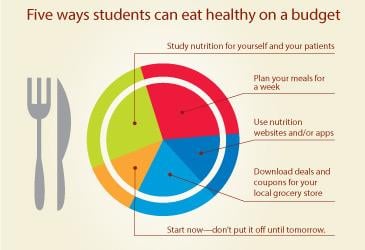Busy medical students often want to eat healthy, but their schedules and budgets can impede that. March is National Nutrition Month, the perfect time to learn how to plan meals that fit your lifestyle.
Shannon Brockman, a registered nutritionist and fourth-year medical student at the University of Florida College of Medicine, said she understands why her fellow peers may struggle with nutrition.
“With cost and convenience on the mind, it is easy to make unhealthy choices during medical school,” she said. “Lunch-and-learn meetings often serve free pizza and a variety of fast-food establishments decorate hospital food courts. During the clinical years, early mornings, late nights, and weekend shifts often leave students with very little options other than a few fast food restaurants. Although some choose slightly healthier sub shops, many eat pizza or chicken and fries on an almost daily basis.”
She said most medical students know how to eat healthy, but fail to translate that knowledge into a well-balanced diet while living off loans with little time for meals. So how can medical students eat healthy on a budget and save time? Check out Brockman’s list of student-friendly tips:
- Plan your meals for a week - While medical students are busy, one day of meal planning can shave hours from your week and help you waste less. “If you keep a planner or calendar to-do list, block off time during the week specifically for meal planning, grocery shopping and cooking,” Brockman said.

- Use nutrition websites and/or apps - Try sites like Supercook and Gojee, which help you use ingredients you already have in your fridge to create delicious, healthy meals. Gojee also can generate cooking tips and photos based on your food cravings.
- Download deals and coupons for your local grocery store - It may be easy to forget, but most major grocery retailers list their sales and downloadable coupons online. Check out the website for your local grocery store to plan meals and shop for groceries based on the week’s savings.
- Study nutrition for yourself and your patients - “To me, the most important thing for medical students to learn is that there are so many valuable resources in the hospital and the community to support the health and nutrition of our patients,” Brockman said. “But in order to access those resources, we must understand their appropriate use ourselves. As students, it’s important that we develop a good knowledge base about common nutrition-related diseases and interventions, so that we are confident giving basic recommendations to our patients.”
- Start now - With busy schedules and long work hours, it may be tempting for medical students to delay meal planning— but try to avoid that. “The challenge with nutrition in medical school is that most people know what to do; it’s just doing it that’s the problem,” Brockman said. If you’re ready to jumpstart your healthy eating, but don’t know where to begin, visit the Academy of Nutrition and Dietetics and the American Heart Association for more tips about eating healthy on a budget.
Tell us: How do you eat healthy on a budget? Share your tips in a comment below or at the AMA Medical Students’ Facebook page, where students will share articles and more information specifically focusing on nutrition throughout March.





